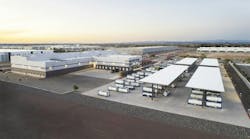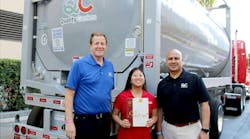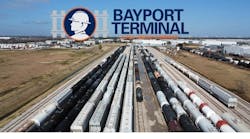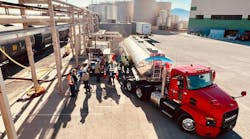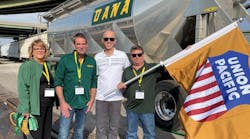At the end of December 2007, Kombiverkehr KG, Frankfurt, Germany, “broke the sound barrier” of one million truck consignments per year with a Hoyer tank container. This is a first in the company's history. The 20-foot tank container was transported by train nonstop from Hamburg, Germany, to the Verona terminal in Italy.
Kombiverkehr KG is the first European intermodal transport operator to move more than one million truck consignments from road to rail in one year, reducing more than 980,000 tons of carbon dioxide.
Hamburg-based Hoyer has been actively supporting intermodal traffic since its beginning in the 1960s. Together with 55 other cross-border forwarders, it was one of the founding companies of Kombiverkehr KG in 1969. Walter Hoyer, company owner at that time, was a member of the first administrative board. Today Thomas Hoyer represents the Hoyer Group on this board.
In 2007, more than 140,000 transports were operated in the entire intermodal business. This is an increase of 10.5 percent compared with the previous year. Kombiverkehr KG handled 44,000 truck consignments in rail transports.
An example for the company's commitment towards intermodal transport is the investment in the terminal in Schkopau. The total investment amounted to about 10 million euros, partially subsidized by the Federal Ministry of Transport, Building and Urban Development. The terminal is operated by KTSK Kombi Terminal Schkopau GmbH. KTSK made the Hoyer branch office to serve as “Gateway East.” The terminal provides regular connections between Schkopau and the national and European rail network to the east. The terminal covers an area of 34,000 square meters, with an office building, a dangerous goods area, two parallel railway tracks, and a huge container gantry crane for handling containers and swap bodies. Dangerous goods storage, 2,500 container parking lots, facilities for changing inlays of box containers as well as for cleaning and maintenance and repair are available.
Another major project is the dangerous goods terminal in the chemical park of Dormagen with rail sidings and gantry cranes for a combination of road and rail. The focus of investment in Dormagen is on the open-air container dangerous goods terminal, where the third extension began operation in April 2007.
Business development at this location was extremely successful. Storage capacities have been increased from 300 to 480 tank containers and/or from 8,900 to 14,300 tons of dangerous goods respectively. This tripled the capacity since the first extension in September 2002.



